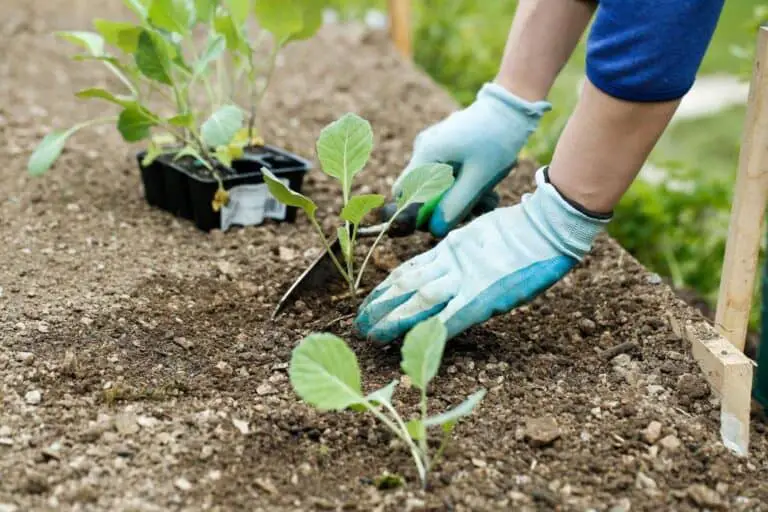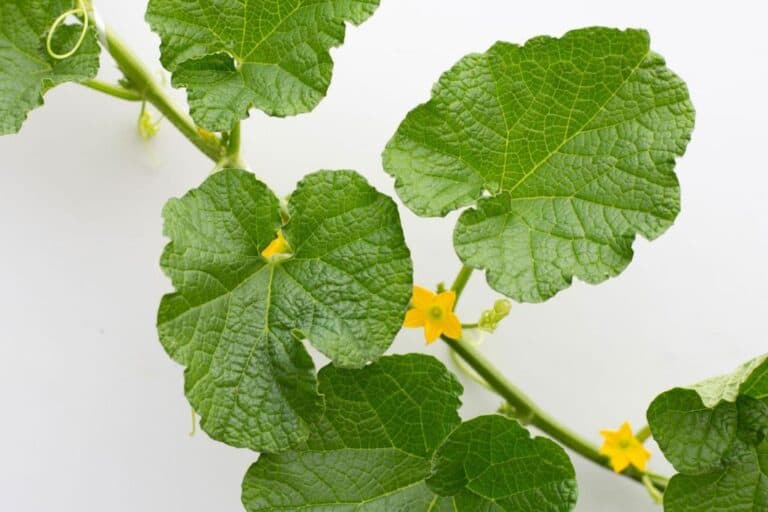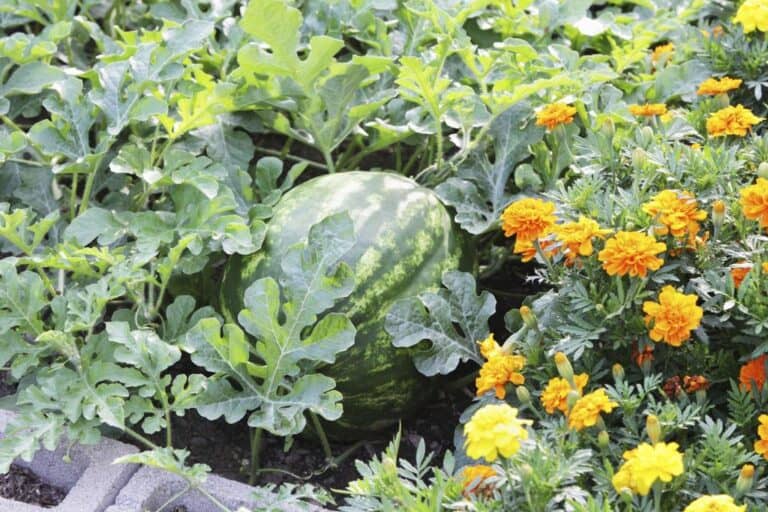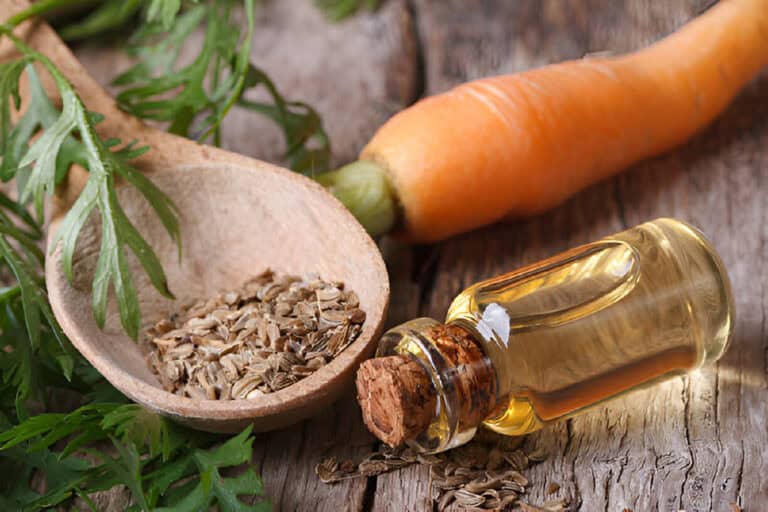10 Most Delicious and Popular European Cantaloupes You Must Try

If you’re a fan of sweet and refreshing fruit, then you’re probably familiar with the delicious and juicy taste of cantaloupe. However, did you know that there are several different varieties of cantaloupe that are popular throughout Europe?
These fruits have been grown and eaten in different parts of Europe for hundreds of years. Each one has its own taste and look. From the vibrant orange flesh of the Melon du Quercy to the firm yet succulent texture of the Melão de Santa Maria Açores, European cantaloupes offer a variety of tastes and textures to explore.
Join us on a mouth-watering journey as we discover the most popular European cantaloupes that will make your taste buds dance with delight. In this article, we’ll explain the different types of European cantaloupe and why you need to try them out. So, if you’re ready to explore the world of European cantaloupes, read on to learn more!
History of the European Cantaloupe
The history of the European cantaloupe dates back many centuries. People think that the fruit came to Europe from Asia or Africa, where cantaloupe was grown and eaten, because of how good it tasted and how good it was for you. Over time, the fruit became more and more popular in Europe.
The word “cantaloupe” comes from an area in Italy called Cantalupo, which is close to Rome. In the 16th century, the Pope’s private gardener grew cantaloupes for the Vatican, and it is believed that the fruit’s popularity in Europe was due in large part to the endorsement of the Catholic Church.
Even though cantaloupes are very popular, there is some confusion about what they really are. Fruit experts note that the commonly eaten cantaloupe is not a cantaloupe at all, but rather a muskmelon. The distinction between the two is primarily based on the netting of the rinds. Scientifically, a melon with netting is classified as a muskmelon, while a melon with little or no netting is called a cantaloupe.
What Is the Difference between European and North American Cantaloupe?
Europe and North America have cantaloupes that look and taste very different from each other. Even though they are different in these ways, the nutritional value and health benefits of both are mostly the same. They have high levels of vitamin A, vitamin C, and potassium.
One of the main differences between North American and European cantaloupes is their skin. The skin of the North American cantaloupe has a net-like appearance, while the European cantaloupe has light green skin.
Both types have skins that can be eaten, but most people take them off before eating the fruit. The net-like skin of the North American cantaloupe is subtler in taste and texture, while the light green skin of the European cantaloupe has a sweeter flavor.
In terms of taste, the flesh of the North American cantaloupe is less sweet than that of the European cantaloupe. The European cantaloupe has a stronger, sweeter flavor, which people who like sweeter fruits tend to like more.
The slow ripening process gives the European cantaloupe a higher concentration of natural sugars, which makes it taste sweeter. The European cantaloupe is usually picked when it is fully ripe, which makes it sweeter and more flavorful than other types of cantaloupe.
The European cantaloupe is often grown in regions with a warm and sunny climate, such as Spain and Italy. Warm weather and a longer growing season let the fruit ripen and develop its own flavor.
Also, the rich soil in these areas gives the cantaloupe the nutrients it needs to grow to its fullest, which makes the fruit sweeter and more flavorful.
Finally, cultivation techniques, such as selective breeding, can also contribute to the superior sweet flavor of the European cantaloupe. Farmers carefully choose and cross-breed different kinds of cantaloupe to make sweeter, juicier, and more flavorful fruits. With these methods and the right growing conditions, European cantaloupes are the sweetest and most delicious in the world.
1. Melon du Quercy
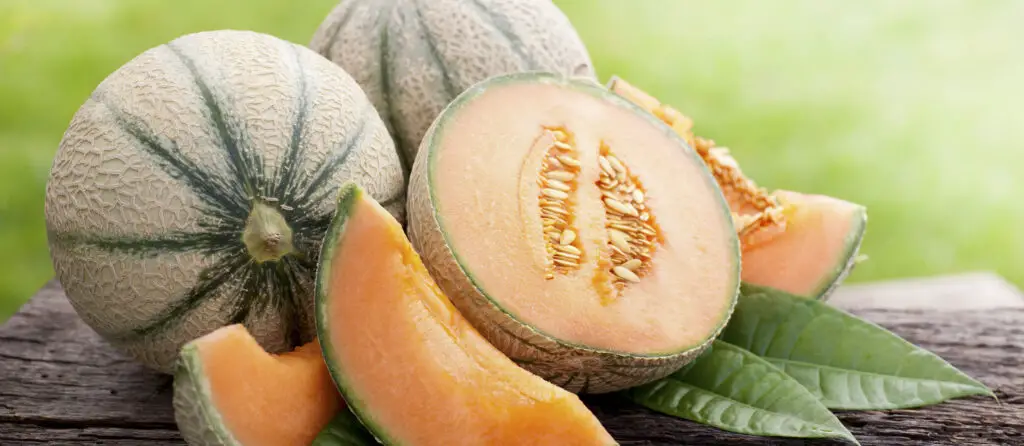
Melon du Quercy is known for its high quality and flavor, and it is a recognized product with a Protected Geographical Indication (PGI) status in the European Union. This means that the melons can only be grown, picked, and processed in a certain area and must follow strict rules and laws to keep their unique qualities.
Most of the time, the melons are picked in August and September, when they are fully grown and taste the best. Then, they are carefully inspected, sorted, and graded by hand to make sure that only the best melons get to the market.
The size of the melons can vary from small to large, and their weight can range from 500 grams to over 2 kilograms.
Melon du Quercy is not only delicious, but it is also a healthy fruit, low in calories and high in nutrients such as vitamin C and beta-carotene. It is a popular ingredient in many dishes, from salads to desserts, and is often paired with other local products, such as foie gras or Rocamadour cheese.
2. Melón de Torre Pacheco-Murcia
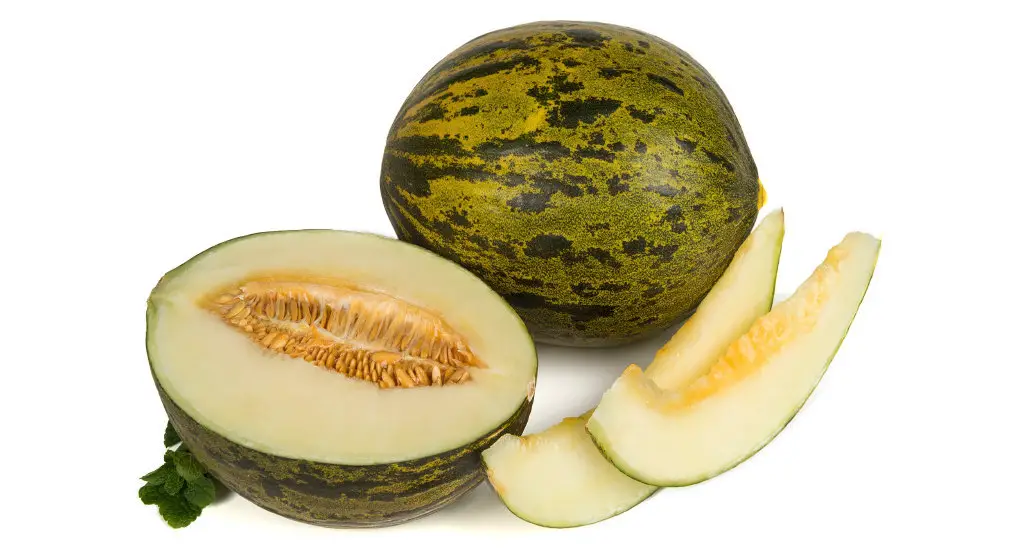
Melón de Torre Pacheco-Murcia is a type of cantaloupe from the Piel de Sapo variety and the Saccharinus Naud. species that is cultivated in the province of Murcia, Spain.
The appearance of the Melón de Torre Pacheco-Murcia is characterized by its smooth, green skin with dark spots and stripes that are evenly distributed across the surface of the fruit. The flesh is succulent and sweet, with a refreshing taste that is enjoyed by people all over the world.
The harvesting season for the Melón de Torre Pacheco-Murcia lasts for only four months, from July to October. During this time, the melons are picked by hand with care to make sure that only the best ones are chosen. After the melons are picked, they are sorted by size and put in boxes made of wood or cardboard so they can be sent to different places.
The Melón de Torre Pacheco-Murcia is a popular fruit in Spain, and it is often used in traditional dishes like gazpacho or served on its own as a refreshing snack. The unique combination of sweet and succulent flavors make it a favorite among fruit lovers, and it has gained a reputation for being one of the finest melons in the world.
2. Charentais Cantaloupe
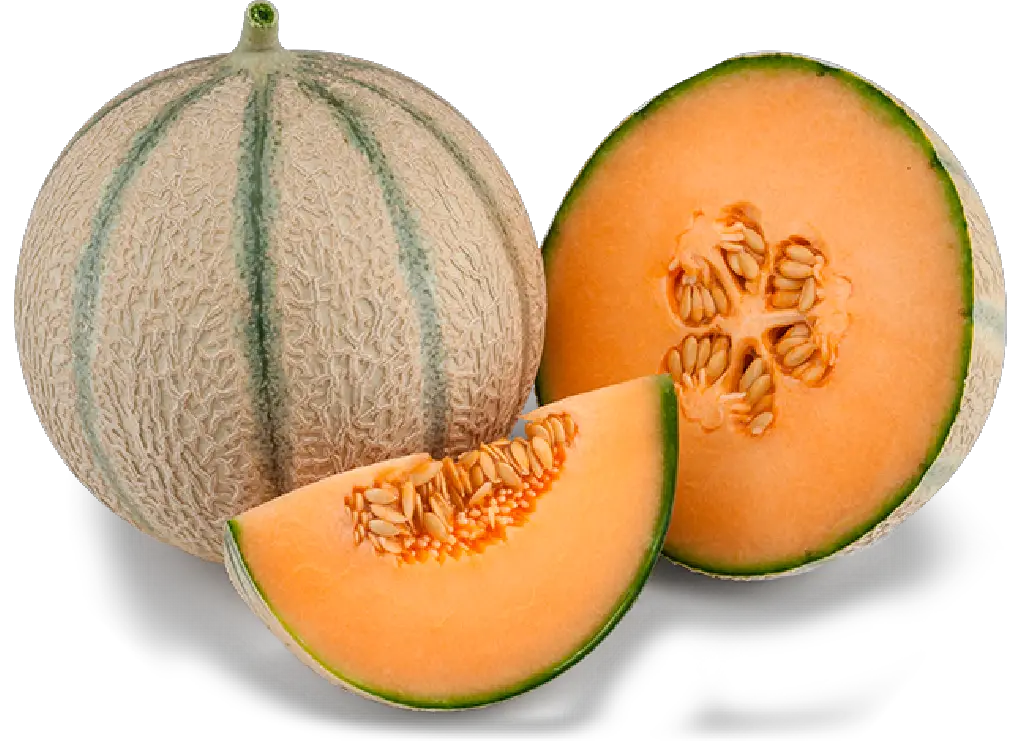
The Charentais cantaloupe grows naturally in the region of Charente in western France. It is a small, slightly flattened, ribbed melon that usually weighs between 500 grams and 1 kilogram. Charentais cantaloupes have a delicate, slightly netted texture on their greenish-gray skin. The flesh of the Charentais cantaloupe is a vibrant orange color and is incredibly sweet and aromatic, with a floral and slightly musky scent.
The Charentais cantaloupe is often described as having a delicate, almost buttery texture, which is what sets it apart from other types of cantaloupes. It is also known for its high sugar content, which contributes to its sweet flavor. The fruit is usually eaten raw and can be enjoyed as a snack or used in a variety of sweet and savory dishes.
Charentais cantaloupes are typically in season from June to September and are a popular fruit in France and other parts of Europe. They are often served as a dessert, either on their own or paired with other fruits and sweet ingredients such as cream or sorbet.
In addition to being delicious, Charentais cantaloupes are also a good source of vitamins A and C, as well as potassium and dietary fiber.
4. Melone Mantovano

Melone Mantovano, as the name suggests, is a type of cantaloupe that is grown in the Lombardian provinces of Mantua and Cremona, as well as in Emilia-Romagna’s provinces of Modena, Bologna, and Ferrara. This fruit is actually a hybrid of honeydew and muskmelon, and is categorized under two main varieties: Tamaris and Supermarket.
Favorable pedoclimatic conditions in the area where Melone Mantovano is grown are one of the reasons why it is of such high quality. With enough sunlight and little rain, the soil and climate in this area are perfect for growing high-quality fruit with great taste and texture. The result is a cantaloupe with a lot of sugar and a lot of mineral salts and potassium. These levels are usually higher than those in melons grown elsewhere.
The Melone Mantovano variety called Tamaris is round and has smooth, pale green skin with a light netting on it. The flesh is firm and juicy, with a bright orange color and a sweet, delicate flavor. The Supermarket variety, on the other hand, is slightly elongated in shape and has a rough, netted skin that is yellow in color when ripe. The flesh is soft and fragrant, with a sweet and slightly tangy taste.
Melone Mantovano is typically eaten raw and can be enjoyed on its own as a snack, or used in a variety of sweet and savory dishes. It is often used as a topping for yogurt or ice cream, in fruit salads, and in smoothies. This cantaloupe is also a good source of vitamins A and C, as well as potassium and dietary fiber, making it a nutritious and delicious addition to any diet.
5. Melon du Haut-Poitou
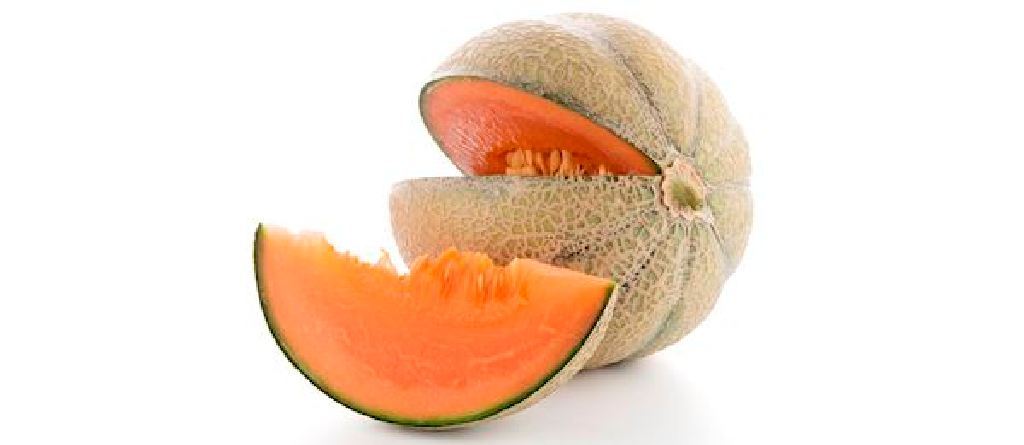
Melon du Haut-Poitou is a type of French melon that is well-known for its yellow flesh and unique flavor. This melon variety is grown in the basin of Haut-Poitou, which is situated in the central part of France.
One of the most distinctive features of Melon du Haut-Poitou is its flavor. The orange flesh of the melon is firm, juicy, and sweet. It also has a unique smell that comes from the region’s good weather. The melons are picked at peak ripeness, and the flesh has a smooth texture that melts in the mouth. These melons are low in calories and sugar, but are rich in fiber and essential vitamins, making them a great addition to any healthy diet.
Melon du Haut-Poitou is a protected product, which means that only a limited number of producers are allowed to grow it. This protection helps make sure that the melons are grown with the utmost care and attention to detail. The melons are packaged and labeled with a mark of origin that proves they are real and were grown according to strict rules. This famous French melon is a real treat that can be eaten by itself or used to make a wide range of tasty dishes.
6. Ogen Melon
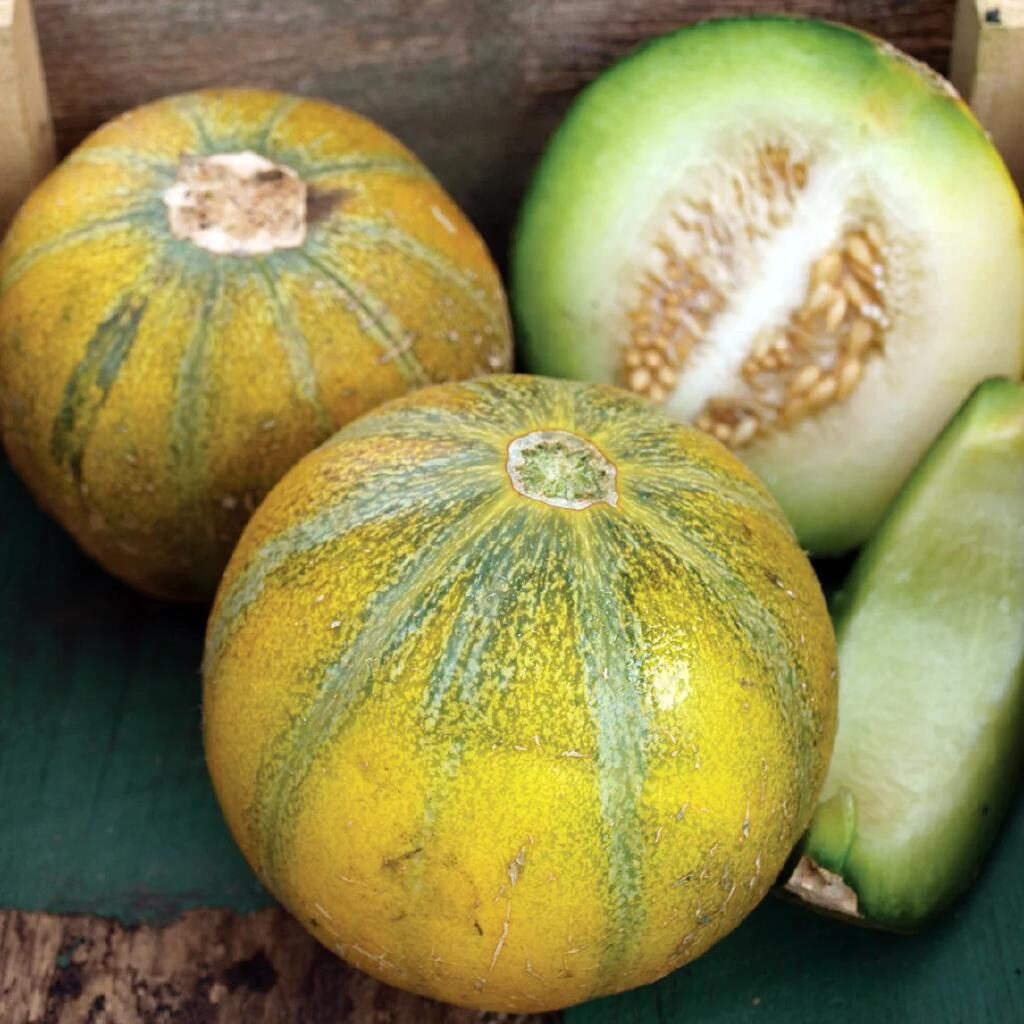
Ogen melon is a type of cantaloupe that was developed in Israel in the 1960s. It is a medium-sized fruit with a round shape and a slightly flattened bottom. The skin of the Ogen melon is green when it is unripe and gradually turns yellow as it ripens. The skin is smooth and has a slightly waxy texture, which helps to protect the fruit and keep it fresh. The flesh of the Ogen melon is a pale green color and has a sweet, delicate flavor.
The Ogen melon has a sweet taste and smell that makes it stand out. It is often compared to a cross between a cantaloupe and a honeydew melon. The fruit has a high sugar content, but it is also low in calories, making it a healthy and satisfying snack. Ogen melons are typically enjoyed raw, either on their own or as part of a fruit salad. They can also be used in smoothies, juices, and other beverages.
Ogen melons are in season from June to August and are a popular summer fruit in Israel and other parts of the world. They are known for their refreshing and thirst-quenching properties, which make them an ideal fruit to enjoy on a hot summer day. Also, the fruit is a great source of vitamins A and C, as well as potassium and dietary fiber.
7. Melón de la Mancha
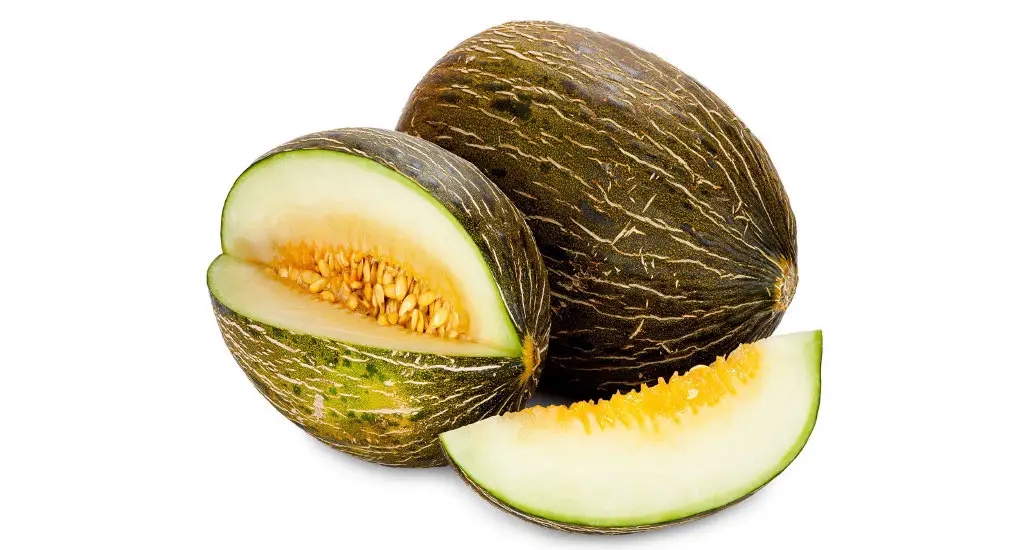
Melón de la Mancha is a prized type of melon that is grown in Spain’s Castile-La Mancha region. This area has some of the best melons in the world because of the way the climate, soil, and traditional farming methods work together. This area grows a type of melon called Pionet or Piel de Sapo, which has a green rind with dark spots and stripes all over the surface of the fruit.
The juicy and sweet pale green-yellow to white pulp of Melón de la Mancha makes it a popular fruit among the locals and tourists alike. The flavor of the melon is enhanced by the hot days and cool nights in the region, which create the perfect environment for the fruit to develop its unique taste.
Melón de la Mancha is harvested from July to October, and only for a short period of four months. It is cut by hand, and the fruits are categorized according to their size before they are packaged and distributed in wooden or cardboard boxes. Local producers take great care to ensure the highest quality fruits, which is why the melon is highly sought after in markets throughout Spain and beyond.
8. Ananas Melon

Ananas melon, also known as Piel de Sapo or Santa Claus melon, is a type of cantaloupe that is originally from Italy but is also widely grown in Spain and other parts of Europe. It is a large, oval-shaped melon with a rough and slightly netted skin that ranges in color from green to yellow. The flesh of the Ananas melon is a creamy white color and is very sweet and aromatic, with a flavor that is often compared to that of pineapple.
One of the unique features of Ananas melon is its rich, tropical flavor, which is why it is sometimes referred to as the “pineapple melon”. It has a lot of sugar and a smell that is similar to that of a ripe pineapple. Most people eat the fruit raw as a snack, but it can also be used in both sweet and savory dishes. It is often used as a topping for yogurt or ice cream, in fruit salads, and in smoothies.
Ananas melons are in season from July to September and are a popular summer fruit in Italy and other parts of Europe. They are often served as a dessert, either on their own or paired with other fruits and sweet ingredients such as whipped cream or honey. The fruit is also high in vitamins A and C, as well as potassium and fiber.
In addition to their delicious taste and nutritional benefits, Ananas melons are also prized for their versatility and durability. The fruit has a thick skin that helps to protect it from damage and extends its shelf life, making it a practical and convenient choice for many consumers.
9. Barattiere Melon
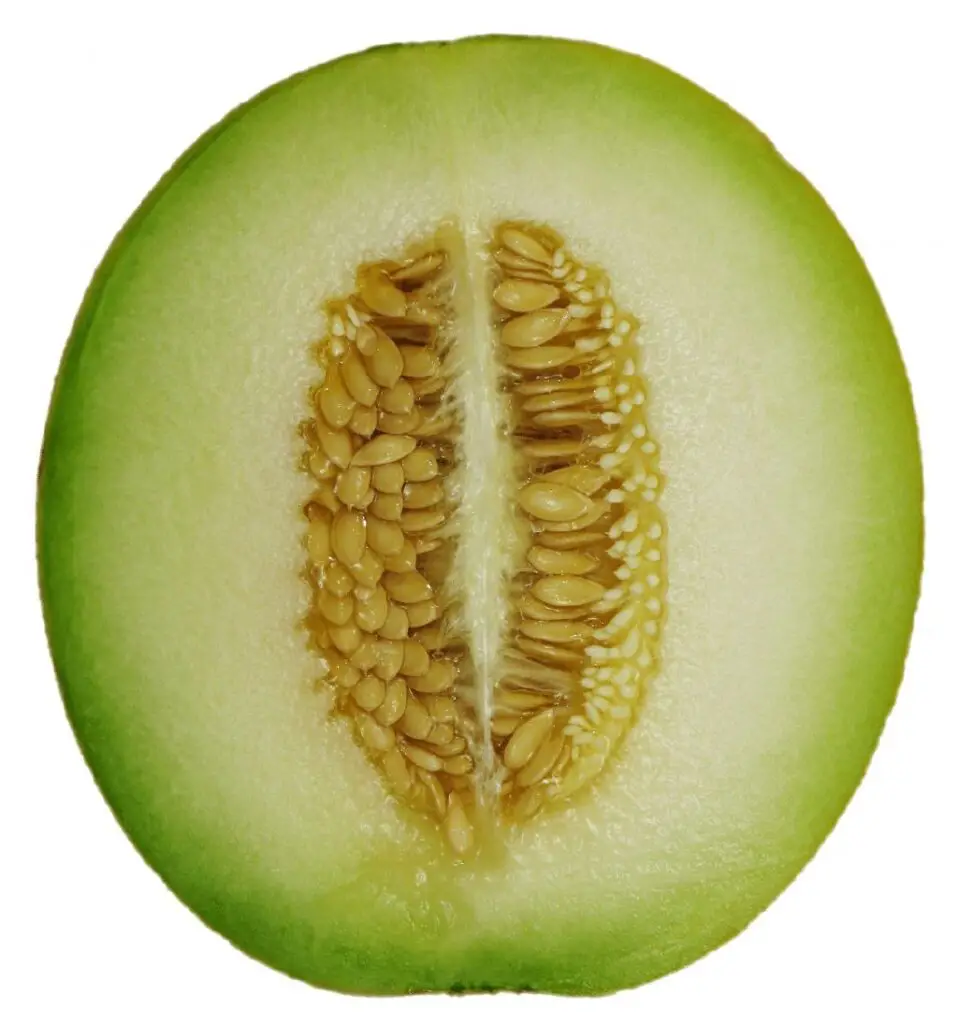
Barattiere is a unique variety of melon that is native to the southern parts of the province of Bari in Italy. Its appearance is distinct from other types of melons, with a round shape and a green to yellow peel. The interior of the Barattiere is crispy and watery, and it has a refreshing, slightly sweet taste that is often described as a cross between a cucumber and a melon. As the Barattiere melon ripens, the interior turns from green to pink, becoming juicier and sweeter in flavor.
The ripening period of the Barattiere melon begins in June, and each plant can produce up to 10 melons. The weight of each melon can vary between 200 and 1000 grams. The best time to eat barattiere is when it is still young and green, before it turns brown. It can be eaten on its own as a snack or used to add a refreshing flavor to salads or other dishes.
Barattiere is liked for more than just how it looks and tastes. It is also good for you. It is rich in vitamins and minerals, including vitamins A and C, potassium, and fiber. As a result, it is considered a healthy addition to any diet. In Italy, Barattiere is often served between courses to refresh the palate, as its fresh and slightly sweet taste makes it an ideal palate cleanser.
10. Meloa de Santa Maria Açores
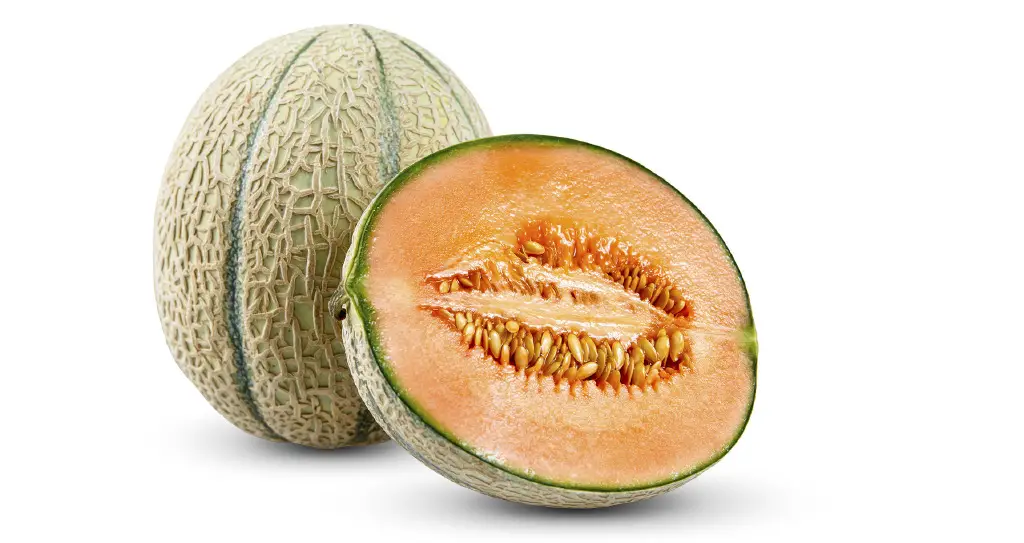
The Meloa de Santa Maria Açores, or the Santa Maria melon, is a unique variety of cantaloupe that is grown on the island of Santa Maria in the Azores archipelago. The melon is known for its distinctive oval shape and heavily crosshatched, greenish-yellow rind. When fully ripe, the pulp is soft and orange in color, and it is exceptionally juicy and sweet.
Meloa de Santa Maria Acores is different from other kinds of melons because it smells and tastes so well. The balance between the sweetness, texture, and flavor of this melon is something truly special and is due in large part to the unique climate of the island of Santa Maria. This unique kind of cantaloupe grows best in this area because of the mild, humid weather and the rich volcanic soil.
The Meloa de Santa Maria Açores is a popular fruit in the Azores, and it is often enjoyed on its own or used in a variety of dishes. Its unique aroma and flavor make it a perfect ingredient for smoothies, desserts, and salads. Also, the fruit is often served with local cheese in a traditional Azorean dessert called “meloa com queijo.”
Conclusion
Cantaloupes from Europe have a wide range of delicious tastes, textures, and smells that appeal to many different tastes. From the sweet and aromatic flesh of the Charentais from France to the pineapple-like flavor of the Ananas from Italy, each cantaloupe variety offers a unique taste experience that is both refreshing and satisfying.
Whether eaten raw as a snack or used in a variety of sweet and savory dishes, these cantaloupes are a popular summer fruit that is enjoyed throughout Europe and beyond. Because they are healthy and can last for a long time, they are a practical and convenient choice for many people.
Overall, while there are differences in appearance and taste between North American and European cantaloupe, both varieties are delicious and offer similar health benefits. Adding cantaloupe to your diet, no matter which kind you choose, is a great way to get more of the vitamins and minerals you need every day.
So, the next time you’re in Europe during the summer, be sure to try out some of these popular cantaloupes and experience their delicious flavors for yourself!

